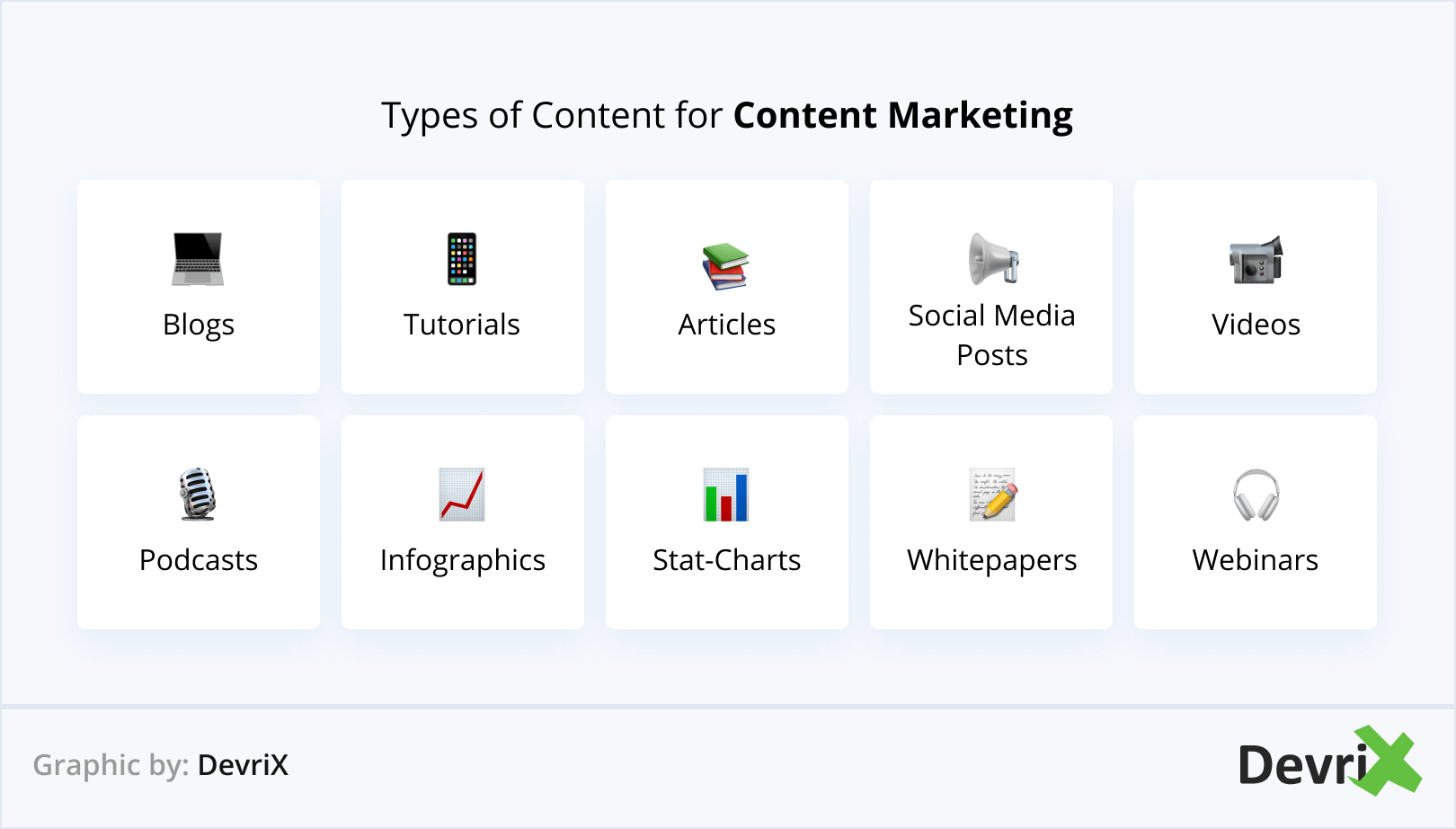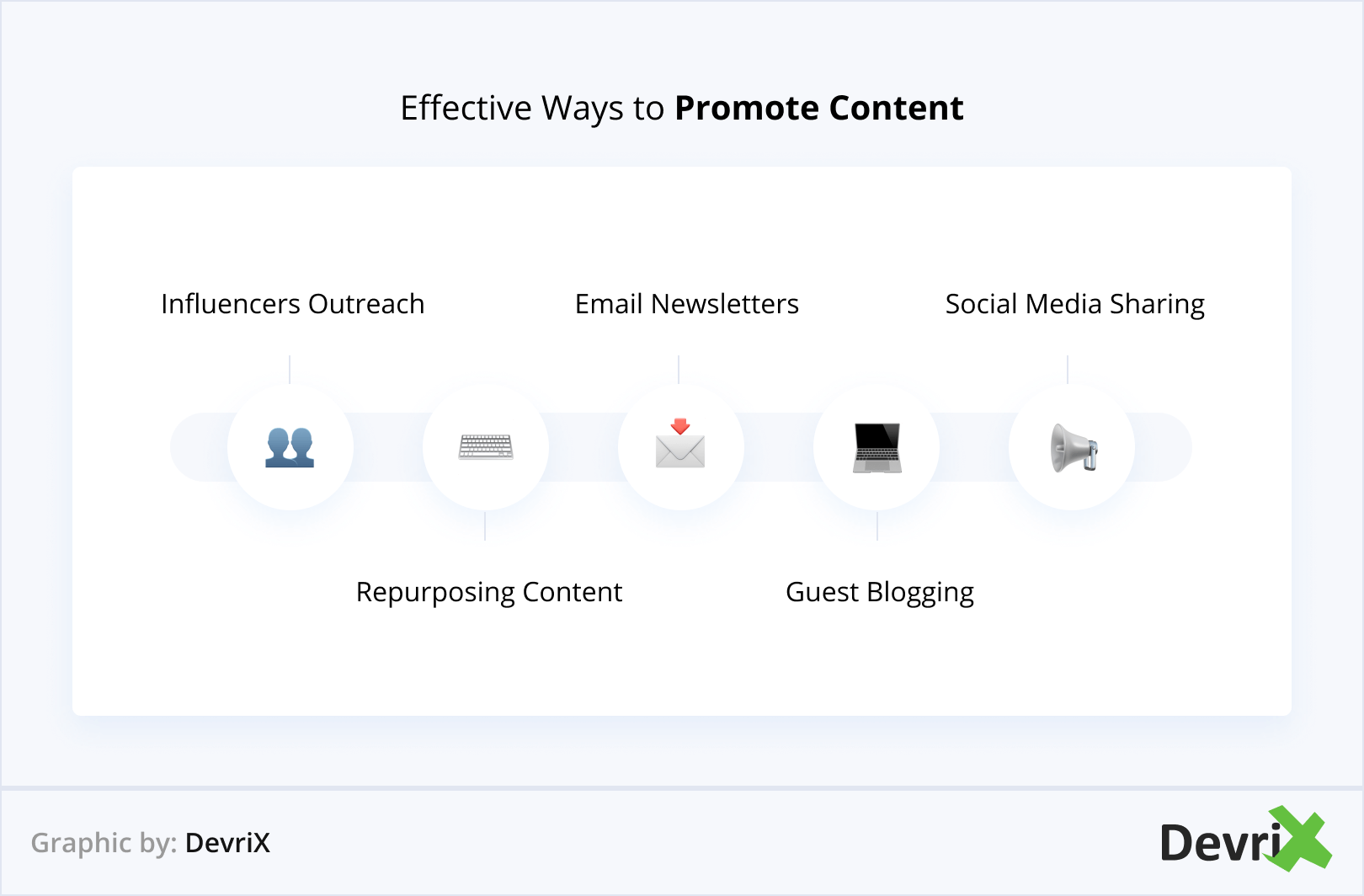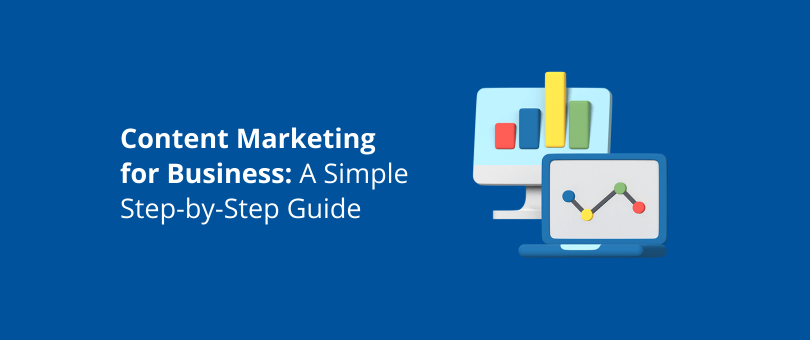Content marketing is a segment of inbound marketing and an efficient long-term strategy to attract your target audience.
It is part of an ongoing tendency for companies to shift their priorities from the push strategy in marketing towards the pull one. The goal is to build a lasting and meaningful connection with their audience and improve customer retention, as opposed to relying on quick one-off transactions.
To be successful, content marketing should be strategically planned and fully integrated into your digital marketing efforts. Thus, it can benefit a company’s digital presence, improve engagement, and boost its online reputation.
In this article, we provide a step-by-step tutorial and practical tips on how to successfully use content marketing for business.
What is Content Marketing?
Content marketing is the practice of creating and distributing informational and educational articles, blog posts, how-to tutorials, guides, videos, and etc. via different marketing channels.
The goal of the strategy is for the company to build trust in its clients and encourage loyalty. In addition, by showing their professional expertise, businesses can boost lead generation and customer acquisition.
Furthermore, providing meaningful and valuable content for a business can consolidate a company’s reputation as an industry thought leader.
Customers nowadays are tired of advertising and prefer to do their own research and base their purchasing decisions on informed choices. That’s why, instead of trying to convince the customer to buy a product, businesses should consider building brand awareness and showing expertise, authoritativeness, and trustworthiness.
Content isn’t ‘stuff we write to rank higher’ or ‘infographics’ or ‘long-form articles.’
Content is all the things that communicates a key message to your audience. Anything.— Ian Lurie, CEO, Portent, Inc.
Building a Strong Foundation for Content Marketing
Before you hop into content creation and start writing you should take a step back and build a strategy. Consider what will characterize your content and what you intend to accomplish with it. These choices may give you clarity and will help you to establish a solid framework. Thus, you will be able to maintain consistency in your content creation efforts and will make your brand more recognizable to your audience.
Furthermore, planning ahead includes obtaining a better perspective on your target audience, your topics, your workflow, and your process. Setting these up in advance will make clear the KPIs you should track and may help you better pursue your objectives.
You will be able to curate your content knowing that it provides the proper foundation to build a connection to your clients and grow your business.

Content marketing is exceptionally powerful when it comes to building brand awareness, improving lead generation, and increasing organic traffic to your website.
Here’s what steps to in order to create a reliable foundation for your strategy:
Step 1: Set up a Team of Professionals
Planning content marketing for business requires the involvement of a marketing strategist or at least a marketing specialist who knows the industry and your business. Consider assembling an in-house team of professionals, hiring a freelancer, or outsourcing the task to a marketing agency.
Your choice depends on the type of experts you have on your team and how experienced they are. If you are not certain that they are up to the task, you should partner up with a third party.
Content creation is not an easy job and requires skills that take a long time to master. If the quality of your articles is not in line with the industry standards, content marketing may have the opposite effect.
Furthermore, even if you have experts on your team that know the topics well, they may not be capable of writing an interesting article.
All in all, your options are the following:
- Hire professional content writers with knowledge in your field.
- Work with experts to write guest posts or edit your content.
- Partner with an agency to manage content marketing for you.
Step 2: Set Your Objectives
When planning your content marketing business objectives, it’s imperative to choose what you need to achieve before you decide how to do it.
The steps below will show you what choices should be made and in what order. Don’t worry if some parts feel tough to accomplish or intimidating at first – with practice and testing, you will soon get the hang of it.
If some of the strategies you opt for don’t show results, you can update or replace them. However, keep in mind that content marketing for business is a long-term strategy and it may take time to see the results. Give it at least a few months or, even better, a year before making any conclusion.
- Stage 1: Choose how you’ll utilize content marketing to develop your business. Decide whether you are going to create a blog with tutorials, a podcast, an resources page with guides, webinars, and other useful tools, etc.You may choose to focus on a single format, or combine a few for a better user experience, and better SEO.
- Stage 2: List and prioritize your objectives. Name one essential objective and a few lower-level objectives for your content marketing endeavors. Be particular about how every objective will help your business develop and why you need it.Specifying relevant KPIs may help you track the performance of your content. In addition, setting up a realistic time frame to achieving your targets may make it easier to identify the efficiency of your strategy.
- Stage 3: Choose how content marketing fits into your overall digital marketing strategy. As mentioned, content creation should be a fully integrated part of your online strategy.This means that it should be consistent with your advertising campaigns and should be featured in all the communication channels you use.
- Stage 4: Create your key message. Your key message is the value proposition you offer to your clients. It may incorporate your story, your business ethics, your reputation in the industry, or your unique perspective on your field.For example, DevriX’s key message is: “Focus on your sales and marketing while we take care of your entire technical infrastructure.”
Step 3: Know Your Target Audience
Defining your target audience is essential for the success of content marketing. You should know what your ideal customer needs, what obstacles they face, how they struggle to overcome them, and so on. Furthermore, you should figure out what kind of people they are – gender, demographics, working status, and so on.
Leveraging this information, you can better understand how your products fit in their life, and how your business expertise may help them in their day-to-day.
To better target their content marketing, businesses build buyer persona profiles that aggregate their audience’s most common qualities, needs, and desires.
However, keep in mind that you should base your personas on what the customers really want, not on what you think they want. The best way to do this is by conducting market research. Relying on data will improve the accuracy of the profiles you create, and will, thus, increase the success rates of your campaigns.
Here are 5 questions that will help you know your target audience:
Question 1: How Old Are Your Target Audience?
Understanding the age scope of your current and prospective clients will help you to gauge which demographic has the quickest enthusiasm for your industry and the monetary support to be a reliable buyer.
Question 2: Where Do They Live?
Learning the whereabouts of your clients isn’t something that only local and SMB businesses should care about.
Knowing where their customers live provides companies with valuable knowledge that may help them to optimize for local SEO, target their social media and PPCs better, and take into account any location-specific needs people may have.
This will give you a better understanding of the customer and may provide unexpected advantages.
Question 3: Are They Mostly Men or Women?
For some products and services, it’s essential to know the gender of your audience.
For example, if you are selling women beauty care products, you should target primarily ladies. However, during the holiday season, you may consider broadening your audience with a male segment, looking to buy presents for female loved ones and family members. You may provide useful present-shopping guides, lists of products, and other relevant content.
Question 4: WHAT ARE YOUR CUSTOMER’S INTERESTS?
Understanding your target audience’s demographics may help you build a better content marketing strategy and find topics that are interesting to your customers.
To attract and keep your customer’s attention, you should create content on topics that they find value in, and that are related to your business and products.
Research what your audience searches online and with what intent. This will help you make a list of keywords for your content. You may include other industry keywords, as well as any other relevant topics.
Furthermore, you should research what kind of searches your customers perform – do they prefer voice or online search. This will help you decide whether to focus on long-tail keywords or short searches.
Question 5: Where Do Your Target Audience Look for Information?
Find out what communication channels your customers prefer. These include the social networks where they hang out the most, their favored search engines, YouTube, email, podcasts, etc.
Find out what content formats work best for different platforms and focus your efforts there.
For example, if your customers love YouTube, you can create practical video tutorials showing how your products work. Or if they are always busy on the go and prefer to listen to audio, you can convert your blog posts into podcasts.
The important thing is to figure out where the customer spends their time online, join them, and share your content the way they like it. This will help you build a connection with the customer, improve engagement, and boost your traffic.
Step 4: Plan Your Strategy
Once you know your audience well, you can proceed with building a content marketing strategy for your business.
Stage 1: Create your key message into an advantages statement or tagLIne
A business purpose statement is your key message to your customer. It revolves around how you can serve their needs and how they will benefit from choosing you over any other company in the marketplace. It’s also a guideline about what type of content you should create to attract the viable clients.
A business purpose statement should be short, meaningful, and enticing. Here are a few tips to help you create one:
- Aim for terse explanations that abridge your center message.
- Think of sets of three powerful words that capture the essence of working with you.
- Make a rundown of your best concepts for taglines.
- Brainstorm ideas with team members, partners, and even clients.
Stage 2: Transform your secondary messages into keywords
The content you create for your website, should be grouped into categories, or pillar pages, based on the top keywords you’d like to target. These should be topics that you’ve identified that your customers are interested in, and that match your area of expertise. Every category should convey one of the secondary messages of your brand.
The keywords should serve as the foundation of the headlines you choose for you content. Consider listing viable subtopics and related subjects. This will help you build a structure for your content, and plan your editorial workflow better.
- List primary, secondary, and tertiary keywords that outline the content you will create.
- Settle on the different types of content that will best serve your needs.
There are various content formats you can explore in your content marketing plan, including, but not limited to:

Pro Tips:
If you are just starting out with content marketing for business, consider running only a blog at first. Once you build up experience, you may experiment with other formats and repurpose the content you already have, or create completely new pieces.
Step 5: Set Content Publication Schedule
Content marketing for business should follow a consistent approach. Before you set up a schedule for your editorial team, consider the time and resources you are able to invest into content creation.
Publishing on the same days of the week, and at the same time will show you as reliable, and may create a habit for your customers to look forward to your posts.
If you don’t think you can produce content at a regular pace, you may need to build up a backlog of articles before you start publishing. This will give you a headstart and will provide you with enough time to keep up with your schedule even when you come across unexpected obstacles.
- Decide how often you will publish. Considering your resources, choose a publishing frequency that you know you can manage. If you are running a small team, it will be close to impossible to post something every day. Usually, the best strategy is to publish once or twice a week. More often may make it hard for you to come up with new topics and maintain the quality of your content, and less often may put your off your customer’s radar.
- Settle on content volume. Your content should follow consistency in length and formatting. However, exactly how long a piece should be, depends on the formatting you choose and the type of audience you are targeting.Keep in mind that according to the current industry standards: an online article should consist of around 1000-1500 words; videos should be shorter than 3 min; and podcasts vary between 25 and 45 min depending on the topic.
- Choose your style. The style of your content and the tone of voice you use also depend on your audience and your brand identity.If your brand is a serious and strictly business one, so should be your content. However, if you follow a more casual communication with your clients, you may transfer this to your writing style as well. Friendly? Witty? Professional? Short and to the point? Brash? Will you permit slang? The decision is yours.
Step 6: Perform Competitor Analysis
Researching your competitors to determine their strategies is always a good business decision. Knowing what your rivals are up to, what types of content they are publishing and which of their topics perform best, will help you work on your own strategy. You may attempt to cover the same topics from a more interesting point of view and add more value. Or you may conduct keyword research to find keyword gaps and content silos and focus your efforts there.
Furthermore, you should consider learning more about your competitors’ audiences and how they interact with content. This may give you ideas on how to win them over, and grow your client network.
Effective Ways to Promote Your Content

While quality plays an important part in content marketing success for businesses, having great content alone is not enough to build up a large audience of target customers. To make sure that they reach KPIs and enjoy the benefits of inbound marketing, companies should also invest in strategic content promotion.
There are different ways to distribute your content, so let’s have a look at some the most prominent ones:
Way #1: Approach an Influencer for a Killer Quote
Influencer marketing is a great way to rise awareness about your work. It gives you access to a highly targeted audience, interested in your topics and may even help you achieve virality.
You can reach out to influencers at scale with BuzzStream. Fill in data about a particular niche or industry, and you’ll obtain a list of contact data for individuals with matching profiles. You can get in touch with them by email or social media, and may request quotes and discuss other ways of networking.
Quotes are a great way to build up backlinks and boost your business reputation as an expert in your field. Furthermore, if you quote the influencer in your content, this boosts the chance of them quoting you back.
However, always do a background check of the influencers you work with and only choose people whom you will benefit from being associated with.
Way #2: Don’t Underestimate the Power of Email Marketing
While it is important to reach a new audience with your content, it’s also vital to make sure that your existing customers see it as well. Your email list is a valuable resource for content distribution and promotion and should be utilized accordingly.
Depending on the scope of topics you cover and the interests of your customers, you can segment your audience and build different newsletters for every group. Your email lists can be based on your buyer personas, or on other criteria relevant to your business.
Research your customer’s day-to-day routine and build a newsletter schedule that will match their habits. This will ensure a better open rate of your emails, more traffic to your content, and better overall results for your strategy.
Way #3: Contact People Who Share Similar Content
Although this may seem kind of obvious, some brands skip on social media sharing and miss out on an opportunity to engage their audience and increase website traffic.
If you’ve done good with your preliminary research, you already know where your customers and prospects love to hang out online. By joining them there and sharing your blog, video, etc., you can increase the visibility of your content immensely. If what you are publishing is interesting and valuable, people may reshare and you will grow your network of followers with new leads.
Furthermore, social media transforms content from a one-way streamline into a conversation. Your customers can comment, ask you questions, and give you feedback on the usefulness of your content. This may help you improve your strategy, learn more about your audience, and create valuable word-of-mouth. In addition, you will be able to build an even deeper connection with your clients.
Way #4: Repurpose Content into Various Formats
Repurposing content is a great way to reach a new audience and increase your website’s visibility in organic search.
There are various tools that allow you to easily transform text into video or audio, or transcribe videos and podcasts, or visualize data. Providing various formats makes your content more accessible and increases the chances of people interacting with it.
Furthermore, multimedia benefits SEO. Search engine algorithms can better understand content when they crawl different versions of it. This may ensure higher SERPs accuracy and may help your pages reach a better-targeted audience.
Way #5: Consider Guest Blogging
Whether you decide to publish content you create on third-party websites or invite popular experts to contribute to your website, guest blogging holds great potential for your content marketing efforts.
This strategy may help you obtain quotes from popular figures in your industry, build some backlinks, enrich your channels with interesting content, and reach a new audience.
In addition, maintaining a good business relationship with other companies and experts in your industry can benefit your overall online presence. They may choose to share your content on other occasions as well, and even recommend your services to their clients.
Examples of Inspiring Content Marketing
Here are some inspiring examples of content marketing:
The Viral Video
Video is highly sharable content, which makes it a great choice if you strive to go viral. The thing about virality, however, is that it’s really tough to plan and optimize for. Content becomes viral because people see something special in it, something extraordinary, and they want to share it with their friends, family, and coworkers. Even if we understand our audience well, it’s difficult to know what will strike their fancy.
However, if you go for epic, and create an unusual combination of factors, you may be on the right track:
Infographics
Infographics are a great approach to wrapping up valuable data, abridging it, and presenting it an easy-to-digest way.
Visuals are a less demanding type of content and make the information more interesting and engaging. Furthermore, they typically get more shared and may be featured in relevant articles by other websites, thus contributing to your backlink strategy.
In addition, if you use third-party data in your infographic and you reference your sources at the bottom and this may, in turn, deliver valuable quotes.
Here is an example of Devesh Design Infographics:
Thought-Leadership Content
Publishing thought-leadership content will consolidate your reputation as an expert in your field and the go-to source of information for anyone who wants to be up-to-date with the industry.
Read more on how to become a thought-leader in your field here:
Thought-Leadership Marketing: How to Become an Industry Thought-Leader
Bottom Line
Congrats! You are well on your way towards getting your content out into the world and reaching the largest audience conceivable. Continue writing and continue promoting, and soon you will see the results coming in!
However, don’t forget to track how your articles are performing, and make improvements if they are not meeting your expectations. Furthermore, make sure you are doubling your SEO efforts and staying in touch with the latest SEO trends. That is how to become a content marketing ninja.





![6 Ways to Strengthen Your B2B Content Marketing Strategy [Part 1]](https://devrix.com/wp-content/uploads/2019/12/6-Ways-to-Strengthen-Your-B2B-Content-Marketing-Strategy-Part-1@2x-380x160.png)